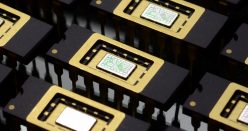Author: szeloof
Silicon Wafer Low Temp Anodic Oxidation Attempt in Aqueous Potassium Nitrate Solution
https://www.youtube.com/watch?v=KgTqeUk6XS8
I wanted to try anodic oxidation because it would allow me to grow SiO2 dielectric layers much quicker and also at room temperature. The result, while using potassium nitrate solution, was a very dirty growth later that would only be suited for a field oxide on a diode and far from precise enough for a gate oxide on a FET. Possibly with more refining in the future this could save me a lot of time waiting for furnaces to heat up.
Working R2R DAC Drawn on Paper
Cleaving a Large Silicon Wafer
https://www.youtube.com/watch?v=Su6-Bl29cEM
This wafer has an un patterned copper metalization layer.
Monocrystalline wafers with a known crystal orientation (<100> in this case) can be easily cleaved into small squares (or triangles, depending on the orientation). Traditionally, <100> wafers are used for CMOS/FET devices and <111> wafers are used for bipolar devices. Thermal oxidation, SiO2 etching, and carrier mobility can greatly differ based on orientation. I believe 100 wafers have lower hole mobility than <110> and <111>. <111> wafers have the highest packing density. <100> wafers allow field effect devices to have lower threshold voltages. Many MEMS devices use <110> or <111> wafers.
Growing Thermal Silicon Dioxide on Silicon Wafer
I had the day off school due to a bomb threat so I had some extra time to work in the shop and had my first success with thermally grown SiO2. The process is very simple. At the time, I didn’t have a tube furnace so I put the wafers in a pottery kiln that went up to 1000c and poured 25ml of water into the top of the kiln through a small opening manually every 5 minutes for about 6 hours to saturate the furnace with water vapor. This wet oxidation technique allowed me to grow the field oxide for my first few semiconductor devices, diodes.
RF Gallium Arsenide Heterojunction-based High Electron Mobility FET – Decapped under Microscope
DIY Doppler Radar – LNB Hack
I modified a satellite LNB to transmit as well as receive on 10ghz and connected the downconverted and mixed signal to my scope. I can use it to measure doppler shift and therefore speed of a moving object. I did the modifications by removing HEMT RF FETs and rotating them so their gate is where their drain was and vice versa. The source connections stayed grounded. I then had to cut some of the traces on the board and change a few resistors and things to make the biasing circuity work in reverse. I then capacitively coupled the dielectric resonant local oscillator the the transmitting section that I made. Watch Jeri Ellsworth’s Videos: https://www.youtube.com/watch?v=vDyo_OQFdAc
Received signal is mixed with the local oscillator (10 ish ghz) such that the result is the subtraction of the two signals, aka the doppler shift which can be related to speed.
A similar mod can be done to use these as 10ghz ham radio transmitters: http://www.qsl.net/pa3gco/zelfbouw/blauwkap/bluecap.html

